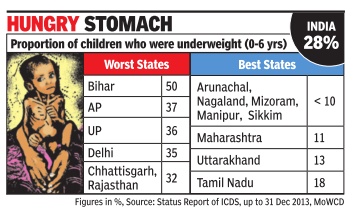Malnutrition: India
This is a collection of articles archived for the excellence of their content. |
Contents |
Areas affected worst
UNICEF, 2009: Uttar Pradesh: "Riskiest state"
From the archives of “India Today”, January 29, 2009
Farzand Ahmed
It’s a human tragedy of massive proportions that everyone seems aware of but is clueless about combating. In Uttar Pradesh, the country’s most populous state and the only one currently to be run by a woman, women run the highest risk of maternal mortality. UNICEF has called the state, the “riskiest state” for babies, especially newborns and mothers.
In its ‘State of the World’s Children 2009’ report, it has also termed the state “the riskiest place for a woman to have a baby in India. In Uttar Pradesh, a woman has a one in 42 lifetime risk of maternal death, compared to a probability of just one in 500 for women in Kerala”.
Only a week before UNICEF presented its report to Governor T.V. Rajeswar, Vice-President Hamid Ansari had curtly remarked at a function in Lucknow that “being born in Uttar Pradesh reduces one’s lifespan by several years. It would seem that the state you are born into determines how long you would live”. Quoting data produced by the National Family Health Survey 2005-06, the vice-president said: “Indeed the picture that has emerged is very distressing.”
The UNICEF report highlights the link between maternal and neo-natal survival, and suggests opportunities to close the gap between rich and poor countries. This is not the first report to paint a gloomy picture.
Six months ago, the state Planning Department had brought out a firstever report titled ‘The State of Children in Uttar Pradesh’. That too made for depressing reading. The study, jointly conducted with UNICEF, revealed that 52 per cent of the state’s children were severely malnourished while the all-India figure was 43. It also revealed that while the percentage of malnutrition among children was just 35 in the least developing world, the figure for sub-Saharan Africa was 28 per cent. South Asia as whole has a 42 per cent child malnutrition rate as against 26 per cent in developing countries.
Several other children in Dhannipur village in Varanasi await a similar fate. Suffering from malnutrition, most of them are children of weavers whose looms once churned out saris. Now out of work, they’re unable to provide their children with proper meals. But Dhannipur is perhaps just a microcosm of the entire state. Peoples’ Vigilance Committee on Human Rights (PVCHR) quotes a state government survey to say that 540 children are still suffering from Grade III and Grade IV malnutrition.
Last year, Bijo Francis of the Hong Kong-based Asian Human Rights Commission circulated a report worldwide saying, “When he (Sahabuddin) died, he weighed six kg. This is Grade III malnutrition (often categorised as severe), a condition that exists in places like Somalia.”
Malnutrition is associated with half of the total number of child deaths and Uttar Pradesh accounts for over 10 million of India’s 72 million malnourished children.
Besides this, it is learnt that nearly 40 per cent of primary school dropouts have been denied mid-day meals provided by the government and other voluntary agencies.
The state Government has some tough paradoxes to deal with. Despite its 40-million-tonne foodgrain production, over 30 per cent of the state’s 17-crore population barely manage to get a single meal in a day. According to the Planning Commission’s ‘UP Development Report’, even though the state is the largest producer of foodgrain, the per capita production is lower than other states.
It’s not just the numbers that are scary. Dr M.Z. Idris, head of the department, community medicine, King George Medical College, Lucknow, adds, “Malnutrition stops total growth of the child, affecting the economic growth of the state or the country.”
But these are not the only issues. The state accounts for the highest number of child abuse and child labour cases besides widespread Japanese Encephalitis (JE), mainly in Purvanchal. JE has turned out to be the biggest killer of children every year.
Last year, over 467 children died and 2,226 were admitted in Gorakhpur Medical College due to JE. Yet the Government’s concerns are not reflected in its actions. When JE sowed panic in the state, the state Government decided to transfer all its JE specialists. Dr Sanjay Srivastava, one of the founders of Action for Peace, Prosperity and Liberty, says he was taken aback because a court order mentions retaining JE specialists.
Clearly, Uttar Pradesh has turned into a land of threatened children. The UNICEF report should ideally be a wakeup call for the state Government.
Effects of malnutrition
Indians are shorter, lighter than world average
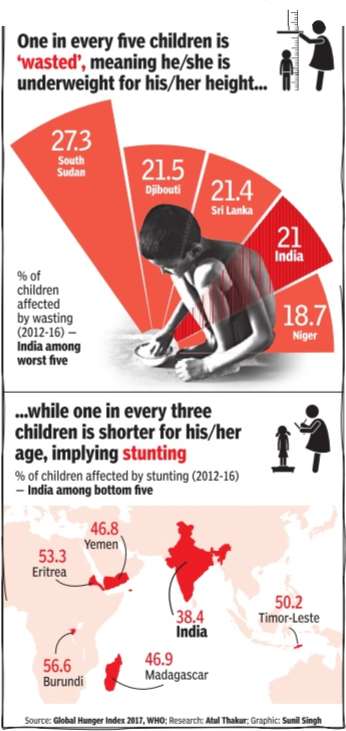
From: The Times of India, October 24, 2017
See graphic:
Percentage of children affected by wasting, 2012-16; Percentage of children affected by stunting, 2012-16, India, Sri Lanka and the world
Malnutrition: its extent, its effects
Anaemia
2005, 2016
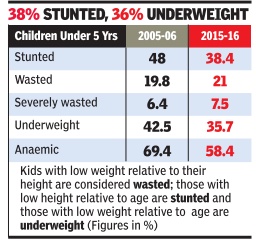
In a stark and chilling reminder of the reali ties of life in India, the recently released fa mily health survey (NFHS 4) results show that over 58% of children below five years of age are anaemic, that is, they suffer from insufficient haemoglobin in the blood, leaving them exhausted, vulnerable to infections, and possibly affecting their brain development.
The survey , which was carried out in 2015 16 and covered six lakh households, also showed that around 38% of children in the same age group were stunted, 21% were wasted and 36% underweight.
While all the internationally accepted markers of children's health have improved since the last such survey in 2005-06, the levels of undernourishment, caused mainly by poverty , are still high and the improvement too slow.
Based on the 2011 Census data, the total number of children under five in India in 2015 is projected at 12.4 crore. So, around 7.2 crore children are anaemic, nearly 5 crore are stunted, around 2.6 crore are wasted and 4.4 crore are underweight. These numbers are not too different from those in 2005-06. Since popula tion has increased, their share is down.
The World Health Organisation says high levels of these markers are clear indications of “poor socio-economic conditions“ and “suboptimal health andor nutritional conditions“.In short, lack of food, unhealthy living conditions and poor health delivery systems. The WHO defines wasting as low weight for height, stunting as low height for age, and underweight as low weight for age.
The survey also found that just over half of all pregnant women were anaemic. This would automatically translate into their newborn being weak. Overall, 53% of women and 23% of men in the 15-49 age group were anaemic.
There is wide variation among states. The data for UP has not been released in view of the ongoing polls, according to Balram Paswan, professor at Mumbai-based International Institute for Population Sciences which was the nodal agency for the survey done for the health ministry . But poorer states like Bihar, Madhya Pradesh, Jharkhand, Assam, Rajasthan and Chhattisgarh have higher than national average rates on all markers.
More advanced states like those in the south, Haryana and Gujarat have slightly better numbers but are still at unacceptable levels. In Tamil Nadu, 51% children are anaemic while in Kerala it is over one-third. In many states, stunting has declined but the share of severely wasted children has increased. These are clear signs of an endemic crisis of hunger in the country that policy makers don't appear to be addressing.
2017: India at bottom of table
Women's health in India is facing a serious nutritional challenge, with the country on the one hand grappling with the largest number of anaemic women in the world and on the other having to deal with diseases linked to obesity which is rapidly increasing among the fairer sex.
Findings of the new Global Nutrition Report 2017 place India at the bottom of the table with maximum number of women impacted with anaemia in the world, followed by China, Pakistan, Nigeria and Indonesia. In India, more than half (51%) of all women of reproductive age have anaemia, whereas more than one in five (22%) of adult women are overweight, according to the data.
The report analysed the situation in 140 countries against targets set in May last year at the World Health Assembly (WHA) held in Geneva.
Experts say that while the government has started to recognise the problem of anaemia and under-nutrition in women, India has made no progress in addressing it as there are too many gaps. The report highlights that the country presents worse outcomes in the percentage of reproductive-age women with anaemia, and is off course in terms of reaching targets for reducing adult obesity and diabetes.
In 2016, the report showed that nearly 48% of women in India were anaemic. India's government is recognizing that the country can not afford inaction on nutrition but the road ahead is going to be long. The Global Nutrition Report highlights that the double burden of undernutrition and obesity needs to be tackled as part of India's national nutrition strategy . For undernutrition, especially, major efforts are needed to close the inequality gap“ said Purnima Menon, senior research fellow in the International Food Policy Research Institute (IFPRI)'s South Asia Office in New Delhi.
Doctors say mere undernutrition is not the cause for high anaemia burden in India.“Only nutrition cannot address the problem. Poor hygiene is a major cause for anaemia because it prevents absorption of nutrition,“ said Dr Indu Taneja, senior consultant, obstetrics & gynaecology at Fortis Escorts Hospital.
Low awareness, illiteracy and the practice of putting the family before self when it comes to care are factors that often deter women in India from taking proper nutrition and care for themselves leading to anaemia, says Dr Taneja. “The impact can be severe at times, especially when it happens in the child-bearing age,“ she said. Anaemia among women in the reproductive age often leads to health issues in the mother as well as the child. While such women are prone to infection and my need blood transfusion during pregnancy , chil dren borne of such women often remain under-developed with poor immunity .
However, the report points out anaemia is a global issue that many women in high income countries also suffer from. The report pegs the prevalence rates in countries like France and Switzerland at around 18%.
Globally, 614 million women aged 1549 years were affected by anaemia. The report found `significant burdens' of three important forms of malnutrition used as an indicator of broader trends childhood stunting, anaemia in women of reproductive age and overweight adult women.
In India, latest figures show that 38% of children under-5 are affected by stunting and 21% of under-5s are defined as `wasted' or `severely wasted', meaning they do not weigh enough for their height. The report found the vast majority (88%) of countries studied face a serious burden of two or three forms of malnutrition. It highlights the damaging impact this burden is having on global development efforts.
Child malnutrition
2006- 2014: Child malnutrition declines, but still very high
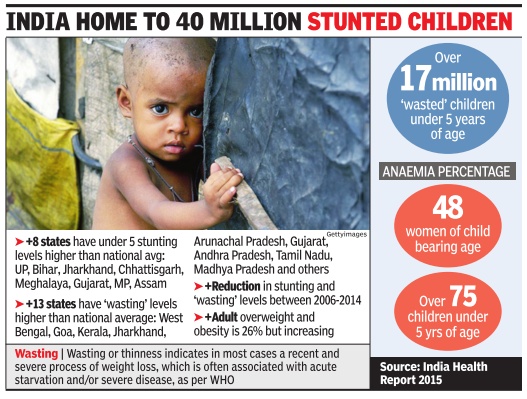
The Times of India, Dec 11 2015
Malnutrition down, but not enough
Child malnutrition in India has declined but continues to be among the highest in the world. Between 2006 and 2014, stunting levels in children under five declined from 48% to 39% as compared to global level of 24%, the India Nutrition Report says.
Being stunted means that the affected children are not fulfilling their potential either in childhood or as adults and their brain and immune systems are compromised, often for their entire life, the reports says. However, there has been an increase in the decline rate of stunting at the national level. “Though India's national rate of stunting decline has increased from 1.7% in 200506, to now 2.6%, it is not fast enough,“ said Lawrence Habbad, senior researcher from International Food Policy Research Institute. A global report assessing India's performance vis-à-vis 193 countries concluded that India was on track to meet only two of the eight global targets on nutrition though it had significantly improved its performance in the past 10 years.
The India Nutrition report and the Global Nutrition Report was released by Union ministers J P Nadda and Maneka Gandhi on Thursday .
Nadda urged for suggestions to accelerate action at state level and strengthening and accountability for impact of nutrition programmes.
In order to strengthen the ICDS programme, women and child development ministry has been undertaking capacity building measures for Anganwadi workers equipping them with tablet devices and giving them promotional abilities, Gandhi said.
2013: Child malnutrition in India, state-wise
`2.3cr children in India malnourished'
Subodh.varma@timesgroup.com
The Times of India Aug 04 2014
Bihar Has Dubious Distinction Of Having Highest Percentage Of Under-Weight Kids: ICDS
About 2.3 crore children in India, up to 6 years of age, are suffering from malnourishment and are under-weight, according to a status report on the anganwadi (day care center) programme, officially known as ICDS. This staggering number amounts to over 28% of the 8 crore children who attend anganwadis across India.
The status report includes state-wise data for underweight children. In Bihar, the proportion of under-weight children is nearly 50%. Andhra Pradesh (37%), Uttar Pradesh (36%), Rajasthan and Chhattisgarh (both 32%) are some of the other large states with a high proportion of children being malnourished.
Delhi reported that a shockingly high 35% of the nearly 7 lakh children who attend anganwadis were un derweight. This shows that the extent of poverty and malnutrition amongst the urban poor is comparable to rural areas despite all the advantages the cities offer.
In all the northeastern states except Assam, Tripura and Meghalaya, less than 10% of children were underweight children. Other large states with a comparatively low rate of malnutrition are Maharashtra (11%) and Tamil Nadu (18%).
There has been no comprehensive survey of children's malnutrition in India since the last National Family and Health Survey in 2005-06. That had estimated 46% of children in the 0-3 years age group as underweight after surveying a sample of about 1 lakh households across the country . The data from anganwadis pro vides a snapshot drawing upon a much larger base.
There were an estimated 16 crore children of ages up to 6 years in the country , as per the 2011 Census. Of these, about half seem to be attending the anganwadis going by the records of the programme. Most of those attending anganwadis belong to poorer sections. But large sections do not get access to it. A 2011 Planning Commission evaluation had said that there is a shortfall of at least 30% in coverage.
There are over 13 lakh anganwadis which look after the kids and provide `supplementary nutrition' to them. As part of their duties, personnel at each anganwadi weigh the attending kids every month and keep a record.
TOI contacted anganwadi workers from several states to confirm the weighing procedures. Till recently, two weighing instruments were provided for each anganwadi center -one pan-type weighing machine for smaller babies and another hanging instrument with a hook at the bottom on which the child is hooked up through a belt or a garment.
In some states, like Delhi, there were cases where the hanging type machine was not in working condition and hence only children up to three years of age could be weighed. In Punjab, Andhra Pradesh, Odisha and Kerala, workers said that they were weighing children up to 6 years.
Why is it that children's weight is not improving despite getting nutritional supplements at the anganwadis?
In many states, the quality of food given to children is very bad and they may not be eating it, according to AR Sindhu of the Anganwadi Workers' Federation. “Often this is the case where food provision service is outsourced to NGOs,“ she said.
Diabetes and poor food habits
Indians' poor food habits fuelling diabetes
The Times of India, Nov 06 2015
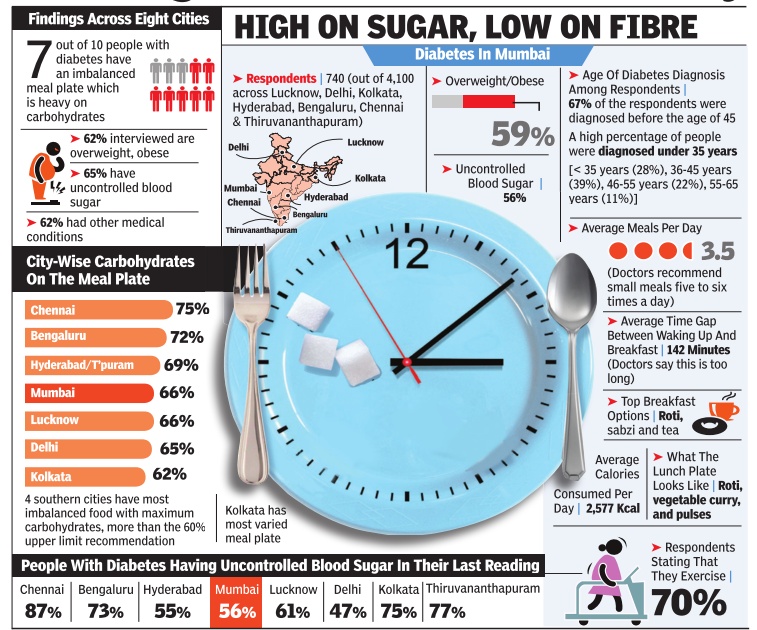
Malathy Iyer
Indians' poor food habits fuelling diabetes, finds survey What Indians eat and how could be fuelling the dia betes epidemic across the coun try, suggests a new survey that interviewed 4,000 diabetic pa tients across eight cities. The main culprit could be the Indian craving for rice, fine flour rotis or upma -all carbo hydrate-based foodstuff high on calories but low on muchneeded fibre. “Rice accounts for 48% of the daily calorific intake of most Indians, said endocrinologist Dr V Mohan from Chennai.
Considering that most types of white rice rapidly increase the blood sugar levels, caution is advised.
But urban Indians who suffers from diabetes seem far from cautious. The new survey , titled Food, Spikes and Diabetes Survey, showed seven out o f 10 people with diabetes in urban India paid little attention to what and how much they eat.Carbohydrates are supposed to comprise only 60% of the plate, but 70% of those surveyed in Mumbai and 84% of those in Chennai consumed more.
There is also a problem with how Indians eat. “Indians tend to eat so fast that the pancreas struggle to produce adequate insulin for metabolising the food, said Dr Shashank Joshi, president of the Indian Academy of Diabetes.
Indian diabetic patients also fail to observe healthy gaps between meals, said Dr Joshi.
Protein deficiency
In 6 major cities, 2017
73% OF URBAN RICH INDIA IS PROTEIN DEFICIENT|Jul 27 2017 : The Times of India (Delhi)
Large sections of Indians cannot afford a balanced diet. But what makes the urban rich follow diets that are low on protein? An IMRB survey reveals the high levels of protein deficiency among the well-heeled and the protein myths they believe.
